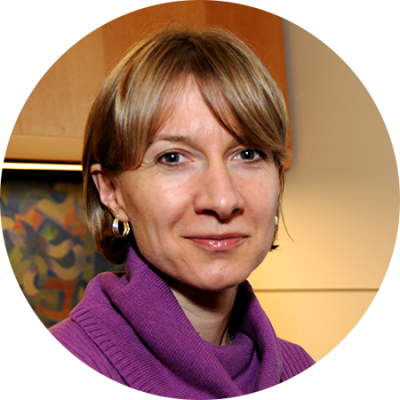Gene Editing Reveals Potential Cancer Treatment Target
Scientists Parse Wide-Ranging Effects of Endometrial Cancer Mutation

By using CRISPR to edit the DNA of tumor cells and examining the effects on protein levels, IRP researchers have identified a possible therapeutic target for a particularly lethal variety of endometrial cancer.
The so-called ‘butterfly effect’ supposes that a butterfly flapping its wings in Brazil can cause a tornado in Texas. While the jury is still out on insect-induced natural disasters, it is clear that a single genetic mutation can have wide-ranging and unexpected consequences throughout a cell. By examining the ripple effects caused by changes in a particular gene, IRP researchers have identified a potential treatment target for a particularly deadly variety of cancer.1
Different types of cancer can behave very differently, even when they originate in the same organ. In the case of endometrial cancer, which begins in the inner lining of a woman’s uterus, a form of the disease called serous endometrial cancer is particularly dangerous because it is frequently resistant to radiation and chemotherapy and has often already spread to other parts of the body by the time it is diagnosed.
Serous endometrial cancer is also relatively under-studied compared to its close cousins. IRP senior investigator Daphne Bell, Ph.D., is one of the few researchers focused on the disease. In a new study, she and IRP staff scientist Mary Ellen Urick, Ph.D., used the CRISPR DNA editing technique to investigate how altering a gene that is frequently mutated in serous endometrial cancer changes the production of thousands of cellular proteins.
“CRISPR editing allows you to precisely manipulate your gene of interest, so if you think you’ve discovered a potential cancer gene or you’re working on a gene that you know is a cancer gene, you can use CRISPR to add or remove a specific mutation in that gene,” explains Dr. Bell. “It provides a much more precise tool to study the cellular effects of mutations than we’ve ever had before.”

Dr. Daphne Bell
The researchers specifically focused on the gene FBXW7, which they had previously found to be mutated in nearly a third of serous endometrial cancers.2 They began with two groups of ‘parental’ cells grown from two different serous endometrial tumors that did not have FBXW7 mutations. They then used CRISPR to insert one of three different FBXW7 mutations into each cell, thereby creating six different varieties of serous endometrial cancer cells with abnormal FBXW7 genes. Afterwards, they measured the levels of thousands of proteins present in the CRISPR-edited cells and compared them to the amount of each protein found in the original, non-mutated parental cells.
Their analysis ultimately identified hundreds of proteins that were present in significantly larger or smaller amounts in the CRISPR-edited cells compared to the non-edited parental cells. One of these proteins, called PADI2, was more than twice as abundant in all six sets of cells with FBXW7 mutations compared to the non-mutated parental cells. While past studies had shown that levels of PADI2 are elevated in many other forms of cancer, Dr. Bell and Dr. Urick are the first to link increased PADI2 production to serous endometrial cancer and FBXW7 mutations. What’s more, preclinical studies have shown that inhibiting PADI2 or decreasing its levels slows the growth of several types of cancer and makes breast cancer cells more susceptible to chemotherapy, making the molecule an intriguing potential target for treating serous endometrial cancer.

Dr. Mary Ellen Urick
“Because the cancer type that we’re studying tends to be resistant to chemotherapy, a combination treatment of traditional chemotherapy with something like a PADI2 inhibitor could be potentially useful,” says Dr. Urick.
The IRP scientists further confirmed the relationship between FBXW7 and PADI2 by using CRISPR to correct an FBXW7 mutation in cells from a different type of endometrial tumor. Correcting this mutation caused levels of PADI2 in the cells to fall. Finally, the researchers confirmed that PADI2 is present in unedited cells from six different serous endometrial tumors.
While the study suggests that elevated PADI2 levels caused by FBXW7 mutations may play a role in serous endometrial cancer, many more experiments are needed before the results could produce a new therapy for the disease. For their part, Dr. Bell and Dr. Urick plan to investigate what happens when they inhibit PADI2 in the cancer cells they examined in their study.
“There are more than 20,000 genes in the human genome, so to pick one of those genes to focus on is difficult,” Dr. Bell says. “Over the last decade or so, we’ve sequenced many serous endometrial cancers to identify genes that are frequently mutated as a way to prioritize which of those 20,000 genes we would study. Essentially, we let the tumors guide us as to where to look. The results of those prior sequencing studies told us to look at FBXW7, and the study of FBXW7 has now guided us to PADI2.”
Subscribe to our weekly newsletter to stay up-to-date on the latest breakthroughs in the NIH Intramural Research Program.
References:
[1] Proteomic profiling of FBXW7-mutant serous endometrial cancer cells reveals upregulation of PADI2, a potential therapeutic target. Urick ME, Bell DW. Cancer Med. 2020 Apr 5. doi: 10.1002/cam4.3013.
[2] Exome sequencing of serous endometrial tumors identifies recurrent somatic mutations in chromatin-remodeling and ubiquitin ligase complex genes. Le Gallo M, O'Hara AJ, Rudd ML, Urick ME, Hansen NF, O'Neil NJ, Price JC, Zhang S, England BM, Godwin AK, Sgroi DC; NIH Intramural Sequencing Center (NISC) Comparative Sequencing Program, Hieter P, Mullikin JC, Merino MJ, Bell DW. Nat Genet. 2012 Dec;44(12):1310-5. doi: 10.1038/ng.2455.
Related Blog Posts
This page was last updated on Tuesday, May 23, 2023
